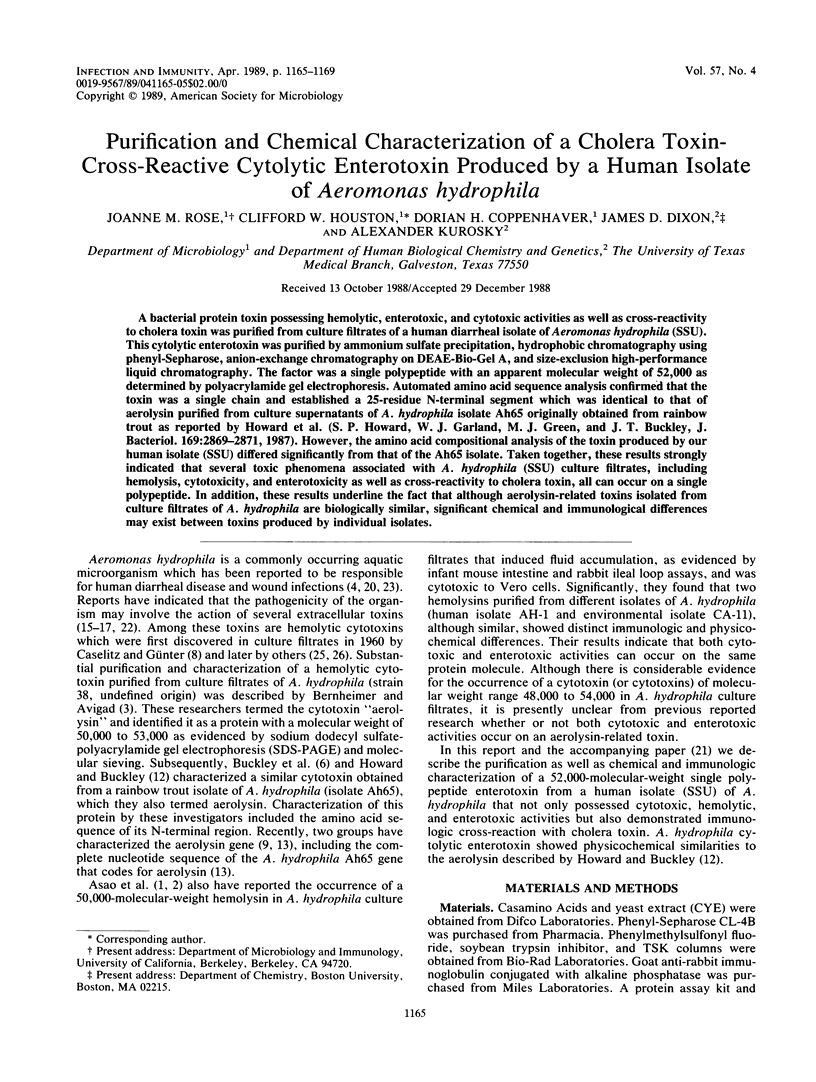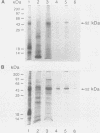Abstract
A bacterial protein toxin possessing hemolytic, enterotoxic, and cytotoxic activities as well as cross-reactivity to cholera toxin was purified from culture filtrates of a human diarrheal isolate of Aeromonas hydrophila (SSU). This cytolytic enterotoxin was purified by ammonium sulfate precipitation, hydrophobic chromatography using phenyl-Sepharose, anion-exchange chromatography on DEAE-Bio-Gel A, and size-exclusion high-performance liquid chromatography. The factor was a single polypeptide with an apparent molecular weight of 52,000 as determined by polyacrylamide gel electrophoresis. Automated amino acid sequence analysis confirmed that the toxin was a single chain and established a 25-residue N-terminal segment which was identical to that of aerolysin purified from culture supernatants of A. hydrophila isolate Ah65 originally obtained from rainbow trout as reported by Howard et al. (S. P. Howard, W. J. Garland, M. J. Green, and J. T. Buckley, J. Bacteriol. 169:2869-2871, 1987). However, the amino acid compositional analysis of the toxin produced by our human isolate (SSU) differed significantly from that of the Ah65 isolate. Taken together, these results strongly indicated that several toxic phenomena associated with A. hydrophila (SSU) culture filtrates, including hemolysis, cytotoxicity, and enterotoxicity as well as cross-reactivity to cholera toxin, all can occur on a single polypeptide. In addition, these results underline the fact that although aerolysin-related toxins isolated from culture filtrates of A. hydrophila are biologically similar, significant chemical and immunological differences may exist between toxins produced by individual isolates.
Full text
PDF




Images in this article
Selected References
These references are in PubMed. This may not be the complete list of references from this article.
- Asao T., Kinoshita Y., Kozaki S., Uemura T., Sakaguchi G. Purification and some properties of Aeromonas hydrophila hemolysin. Infect Immun. 1984 Oct;46(1):122–127. doi: 10.1128/iai.46.1.122-127.1984. [DOI] [PMC free article] [PubMed] [Google Scholar]
- Asao T., Kozaki S., Kato K., Kinoshita Y., Otsu K., Uemura T., Sakaguchi G. Purification and characterization of an Aeromonas hydrophila hemolysin. J Clin Microbiol. 1986 Aug;24(2):228–232. doi: 10.1128/jcm.24.2.228-232.1986. [DOI] [PMC free article] [PubMed] [Google Scholar]
- Bernheimer A. W., Avigad L. S. Partial characterization of aerolysin, a lytic exotoxin from Aeromonas hydrophila. Infect Immun. 1974 Jun;9(6):1016–1021. doi: 10.1128/iai.9.6.1016-1021.1974. [DOI] [PMC free article] [PubMed] [Google Scholar]
- Bhat P., Shanthakumari S., Rajan D. The characterization and significance of Plesiomonas shigelloides and Aeromonas hydrophila isolated from an epidemic of diarrhoea. Indian J Med Res. 1974 Jul;62(7):1051–1060. [PubMed] [Google Scholar]
- Bradford M. M. A rapid and sensitive method for the quantitation of microgram quantities of protein utilizing the principle of protein-dye binding. Anal Biochem. 1976 May 7;72:248–254. doi: 10.1016/0003-2697(76)90527-3. [DOI] [PubMed] [Google Scholar]
- Buckley J. T., Halasa L. N., Lund K. D., MacIntyre S. Purification and some properties of the hemolytic toxin aerolysin. Can J Biochem. 1981 Jun;59(6):430–435. doi: 10.1139/o81-059. [DOI] [PubMed] [Google Scholar]
- CASELITZ F. H., GUENTHER R. [Hemolysin studies with Aeromonas strains]. Zentralbl Bakteriol. 1960 Sep;180:30–38. [PubMed] [Google Scholar]
- Chakraborty T., Huhle B., Bergbauer H., Goebel W. Cloning, expression, and mapping of the Aeromonas hydrophila aerolysin gene determinant in Escherichia coli K-12. J Bacteriol. 1986 Jul;167(1):368–374. doi: 10.1128/jb.167.1.368-374.1986. [DOI] [PMC free article] [PubMed] [Google Scholar]
- Duffy L. K., Peterson J. W., Kurosky A. Covalent structure of the gamma chain of the A subunit of cholera toxin. J Biol Chem. 1981 Dec 10;256(23):12252–12256. [PubMed] [Google Scholar]
- Houston C. W., Koo F. C., Peterson J. W. Characterization of Salmonella toxin released by mitomycin C-treated cells. Infect Immun. 1981 May;32(2):916–926. doi: 10.1128/iai.32.2.916-926.1981. [DOI] [PMC free article] [PubMed] [Google Scholar]
- Howard S. P., Buckley J. T. Activation of the hole-forming toxin aerolysin by extracellular processing. J Bacteriol. 1985 Jul;163(1):336–340. doi: 10.1128/jb.163.1.336-340.1985. [DOI] [PMC free article] [PubMed] [Google Scholar]
- Howard S. P., Garland W. J., Green M. J., Buckley J. T. Nucleotide sequence of the gene for the hole-forming toxin aerolysin of Aeromonas hydrophila. J Bacteriol. 1987 Jun;169(6):2869–2871. doi: 10.1128/jb.169.6.2869-2871.1987. [DOI] [PMC free article] [PubMed] [Google Scholar]
- Laemmli U. K. Cleavage of structural proteins during the assembly of the head of bacteriophage T4. Nature. 1970 Aug 15;227(5259):680–685. doi: 10.1038/227680a0. [DOI] [PubMed] [Google Scholar]
- Ljungh A., Eneroth P., Wadström T. Cytotonic enterotoxin from Aeromonas hydrophila. Toxicon. 1982;20(4):787–794. doi: 10.1016/0041-0101(82)90126-x. [DOI] [PubMed] [Google Scholar]
- Ljungh A., Wretlind B., Möllby R. Separation and characterization of enterotoxin and two haemolysins from Aeromonas hydrophila. Acta Pathol Microbiol Scand B. 1981 Dec;89(6):387–397. doi: 10.1111/j.1699-0463.1981.tb00205_89b.x. [DOI] [PubMed] [Google Scholar]
- MacIntyre S., Buckley J. T. Presence of glycerophospholipid: cholesterol acyltransferase and phospholipase in culture supernatant of Aeromonas hydrophila. J Bacteriol. 1978 Aug;135(2):402–407. doi: 10.1128/jb.135.2.402-407.1978. [DOI] [PMC free article] [PubMed] [Google Scholar]
- Merril C. R., Goldman D., Sedman S. A., Ebert M. H. Ultrasensitive stain for proteins in polyacrylamide gels shows regional variation in cerebrospinal fluid proteins. Science. 1981 Mar 27;211(4489):1437–1438. doi: 10.1126/science.6162199. [DOI] [PubMed] [Google Scholar]
- Nagle G. T., Painter S. D., Blankenship J. E., Dixon J. D., Kurosky A. Evidence for the expression of three genes encoding homologous atrial gland peptides that cause egg laying in Aplysia. J Biol Chem. 1986 Jun 15;261(17):7853–7859. [PubMed] [Google Scholar]
- Rahman A. F., Willoughby J. M. Dysentery-like syndrome associated with Aeromonas hydrophila. Br Med J. 1980 Oct 11;281(6246):976–976. doi: 10.1136/bmj.281.6246.976. [DOI] [PMC free article] [PubMed] [Google Scholar]
- Rose J. M., Houston C. W., Kurosky A. Bioactivity and immunological characterization of a cholera toxin-cross-reactive cytolytic enterotoxin from Aeromonas hydrophila. Infect Immun. 1989 Apr;57(4):1170–1176. doi: 10.1128/iai.57.4.1170-1176.1989. [DOI] [PMC free article] [PubMed] [Google Scholar]
- Stephen S., Rao K. N., Dumar M. S., Indrani R. Letter: Human infection with Aeromonas species: varied clinical manifestations. Ann Intern Med. 1975 Sep;83(3):368–369. doi: 10.7326/0003-4819-83-3-368. [DOI] [PubMed] [Google Scholar]
- Wretlind B., Hedén L., Wadström T. Formation of extracellular haemolysin by Aeromonas hydrophila in relation to protease and staphylolytic enzyme. J Gen Microbiol. 1973 Sep;78(1):57–65. doi: 10.1099/00221287-78-1-57. [DOI] [PubMed] [Google Scholar]
- Wretlind B., Möllby R., Wadström T. Separation of two hemolysins from Aeromonas hydrophila by isoelectric focusing. Infect Immun. 1971 Oct;4(4):503–505. doi: 10.1128/iai.4.4.503-505.1971. [DOI] [PMC free article] [PubMed] [Google Scholar]



